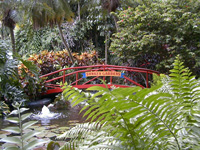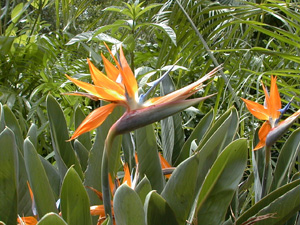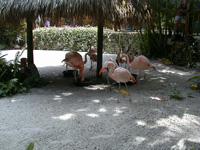Your journey through the area's oldest attraction takes you through a mile-long path set 15 feet below street level. The scent of nectar intoxicates you as your eyes capture a brilliant budding of South Pacific shrubs at every turn. You move deeper into the landscape and pass the trickling waterfalls that feed into tiny pools where koi and goldfish skim the surface looking for a handout.
The ground you stand on was once all lake. When George Turner purchased it in 1903 he drained it in order to plant in the rich soil below. In the 1920s he noticed people enjoyed walking through his plush surroundings and in true capitalist fashion started charging a nickel for the pleasure. In 1935 Turner's Sunken Gardens became an official page in the Florida guidebooks.
You'll notice an edging of political correctness along the garden's walkways. Gone are the days of the tacky souvenir shop and the cheap thrill of alligator wrestling. The coconut monkey statues and seashell animal assemblages have all but vanished. The Rainforest Information Center has taken their place. The pavilion in which Kachunga & the alligator once wrestled and raised activist voices with "gator pain for monetary gain" is now center stage for wildlife rehabilitators. Several times a day they give their spiel on living in harmony with animals… animals that wouldn't give a second thought to poking your eyes out or having you for their next meal. Penny Boehme is one of the lecturers, who by her own admittance lives with a menagerie of bats, possum, hawks and owls. And you thought a dog on the bed cramped your sex life. All in all there are few animals left to Sunken Gardens aside from a couple of Godzilla-sized iguanas, some token flamingos and a bald eagle whose lunch of dead fish adds a pungent odor of reality to the serene scene. Most cages from days of old are marked "future education exhibit".
Some of the best wildlife, is not caged or even contained in the walkthrough butterfly aviary, but rather are the meandering visitors to Sunken Gardens. Found along the paths, looking for a sanctuary of shade, are pigeonholes of white-haired wonders masked in thick cataract sunglasses as if hiding from a paparazzi in the trees. Their mates mosey alongside, protecting their belly buttons with hiked up shorts in an exotic array of colors you never thought possible. Although most have headed north for the summer, you can still spot a snowbird or two mingling among the palm groves.
To those who remember the heydays of Sunken Gardens, its walls still hold a genuine attraction. To those who can see past the liberal glitter of a kinder, gentler Sunken Gardens, a shimmer of nostalgic appeal still permeates from the deco script sign on 4th Street. Anyone who would venture in from the hustle and bustle of the outside world would surely be taken aback by the mere enormity of botanical marvels which have rooted themselves here for the last 65 years.
Update 6/01: The city of St. Petersburg has given the go ahead to a plan that will redesign the Sunken Gardens entrance. Will this be the end of that beautiful sign on 4th Street? What is this button?
Sunken Gardens |



